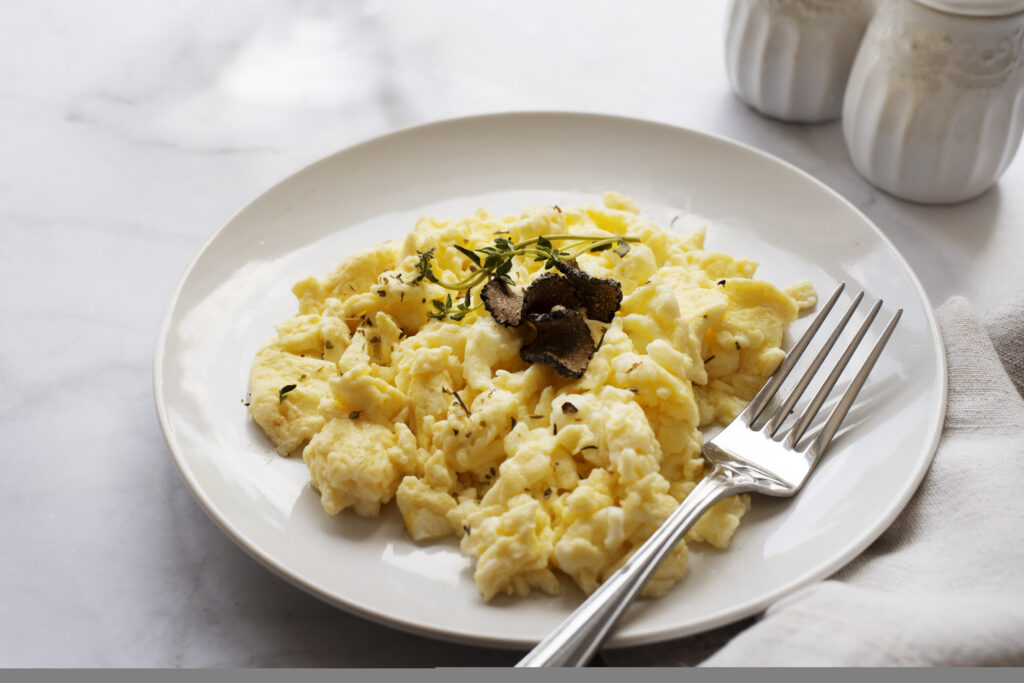
Best Scrambled Eggs In The World –
Ah, scrambled eggs – a breakfast classic that’s both simple and delicious. Whether you’re a culinary novice or a seasoned home chef, perfecting the art of making scrambled eggs is a worthwhile endeavor. In this blog post, we’ll guide you through the steps to create the fluffiest, most flavorful, and best scrambled eggs in the world you’ve ever tasted.
- Consider a nonstick skillet – I’m sure some of you will attest to your superb scrambled eggs in your well-seasoned cast-iron pan. Don’t allow me to stop you if that’s the case! For anyone who has had problems with eggs burning or sticking to the skillet, nonstick can be a lifesaver. In reality, most pans—even the best ones—are full of tiny fissures and cracks. Eggs can get stuck in those minute cracks when a pan is heated because the metal expands as it heats, which causes the eggs to stick and burn.
- Use a smaller skillet – Use a smaller skillet as it’s one of the simplest preventative measures against overcooking. I love making very thin omelets to fold into sandwiches in my 12-inch nonstick skillet. However, because of their larger surface area, eggs can easily dry out soon. Depending on how many eggs you’re cooking, you might want to reduce the size of the skillet to 10 or even 8 inches if you want true curds (whether dense and creamy or light and fluffy).

- Salt – A little more salt than my instincts would lead me to believe has produced a noticeable difference in flavor, at least from a taste viewpoint. My eggs have improved from being bland to being flavorful, as you could expect!
- Salting scrambled eggs is necessary for another reason, too: it can enhance their texture. The proteins in both the yolks and whites of eggs coagulate when they are heated (more on that below). The eggs get more dry and leathery when this occurs more frequently. Therefore, it is important to prevent those proteins from encroaching on one another and squeezing out water. To do that, salt can be useful. In a way, salt acts as a barrier between the proteins. He advises salting eggs at least 15 minutes before cooking to allow the salt to dissolve evenly, however doing so right before cooking also works. He discovered that adding salt at the end of cooking led to harder, liquid-dripping eggs. In scrambled eggs, add a few drops of lemon juice. Similar to salt, acid has an impact on how proteins bind, in this instance changing the rate and density of coagulation.
- Heat – Temperature management is the secret to the best scrambled eggs in the world recipes. The largest threat to scrambled eggs is overheating since, as we’ve seen, it produces unpleasant textures. However, adjusting the heat also lets you choose the type of scrambled eggs you want. Heat is required to create steam and cause the eggs to expand if you enjoy fluffy curds. How much and for how long is crucial? The use of both high and low heat—starting at medium-high and lowering it once a spatula pulled across the skillet left very little trace of raw egg—helped produce copious yet delicate eggs. For denser eggs with few or almost no curds, just use low heat. Additionally, using a saucepan slows down the evaporation of moisture. You could also utilize a double boiler configuration, which involves setting a bowl over a pan of simmering water.
You don’t want the proteins to begin unfolding and then joining together before the cooking process even starts, so don’t beat the eggs too vigorously before scrambling. The amount of stirring you do during cooking also has an impact on the final product. Contrary to what you may have done in the past, continuous stirring or whisking will cause any pockets of steam to burst, resulting in denser, smoother eggs. If you desire large, fluffy curds, gently fold and swirl as little as possible to ensure even heating. For smaller curds, stir a little more frequently.
- Adding Fat – Another factor that promotes softness and prevents proteins from attaching properly is fat. You’re on to something if you’ve always pounded milk into your eggs without thinking about it. The results will be denser and creamier if even fattier components are used. Consider cream fraiche. Additionally, heavy cream is very rich. Since I never have half-and-half on hand, I usually just use equal parts heavy cream and 2 percent milk instead of Souza’s suggested halfway house of half-and-half (1/4 cup per 8 eggs). Adds two egg yolks, which also enhances the flavor and color of the eggs, to make up for the dairy fat being slightly reduced. Butter is the ultimate additive. I added a staggering 4 tablespoons of chopped butter to 4 eggs after being inspired by Nosrat’s inclusion of a dish by author Alice B. Toklas. These eggs were the richest, most opulent, and filling I’d ever made — I didn’t eat them again for several hours! — thanks to that and the steady stirring. Although not a typical meal, this example clearly illustrates the idea.
Avoid overcooking. It’s true that saying than doing. I’ve found that the best suggestion is to take the eggs from the heat just before you think they’re done, allowing the residual heat to do the job. As long as 30 seconds, according to Nosrat, “Let your courage carry you, and the eggs, to the finish line.”
